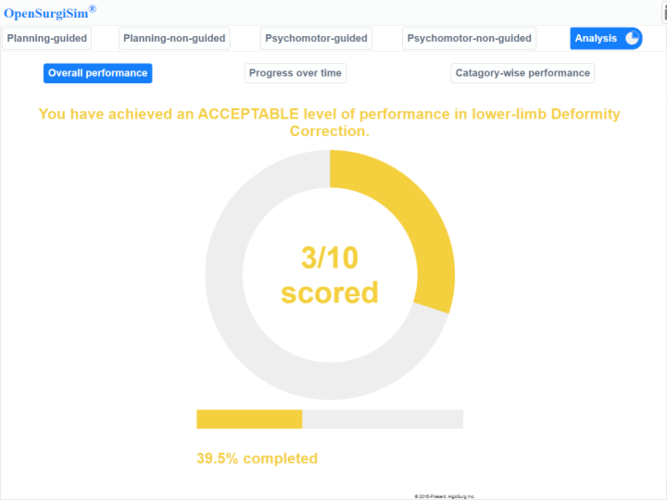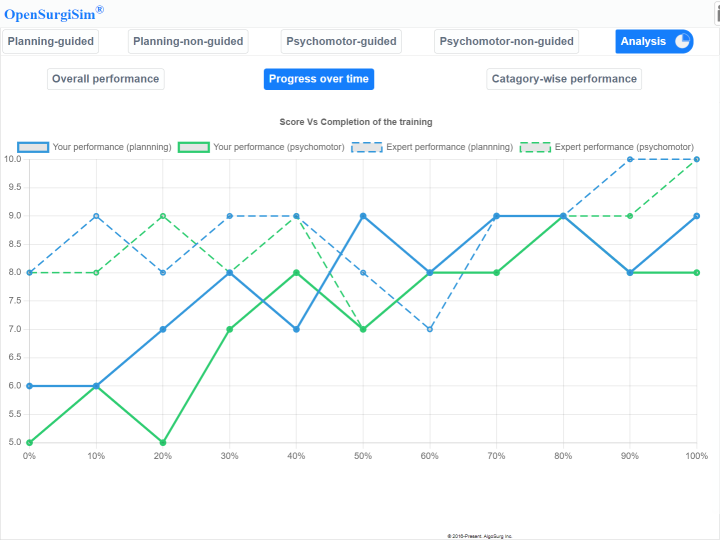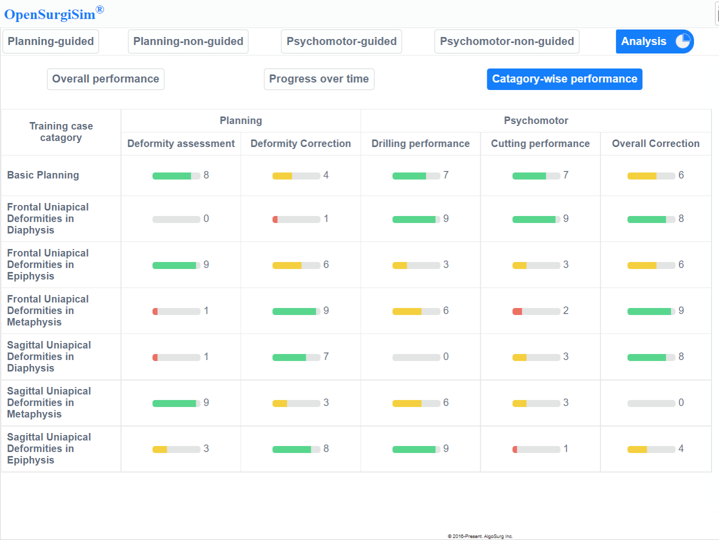The performance measurement for the Self-Assessment is integrated with each sub-module. How the performance is measured and shown to trainee for the Surgery-Planning sub-module is given here. How the performance is measured and shown to trainee for the Psychomotor-Training sub-module is given here.
This page is regarding the analysis of the measured performance given in OpenSurgiSim through the Analysis section/sub-module of the software. The Analysis sub-module shows analysis and overall score of the Trainees, calculated from the individual scores of all the case-studies performed by the trainee in: Surgery-planning Sub-modules (Guided and Non-Guided) and Psychomotor Sub-modules (Guided and Non-Guided).
The analytics and scoring will help Trainee surgeons to self-assess how well they have learned as they go through each stages of Guided Surgery-planning, Non-guided Surgery planning, Guided Psychomotor and Non-guided Psychomotor sub-modules. It also helps them to self-assess how skilfully they can perform under the non-guided surgery-planning and non-guided psychomotor training through the smart automatic scoring system which has been developed after benchmarking the scoring system with respect to the skills of expert trainer surgeons.
Now how these performances and scores are compiled together to give a meaningful analysis for improving training pathway is given below.
Analysis sub-module[edit | edit source]
The analysis sub-module shows the performance of the Trainees in bone deformity correction in three formats. They are as follows:
Overall Score[edit | edit source]

In this format, the sub-module score, sub-module completion level, category scores and category completion level for both Surgical planning and Psychomotor sub-modules are averaged to get a single score and single completion level. This single score and single completion level will help trainees in self-assessing how much training they have gone through and how they performed overall. The trainees can self-assess whether they need to do more case studies to improve their scores.
Progress over time[edit | edit source]

In this format, the sub-module scores for Surgical planning and Psychomotor training are shown as a time-graph. This will hep trainee to self assess how they have been performing over the time since they began the training. The graph will also show how the learning performance curve of an expert trainer varies with time. It will also display how the performance of other trainees using the module is varying over the time. This will help the trainee to self-assess where they stand compared to other trainees and the expert trainer in terms of their performance over time.
Note: The benchmarking of the scoring with respect to the skills of expert trainer surgeons is underway. We have planned to calculate scores of expert trainers while performing case-studies of all the modules. As more trainees use the module, this graph will start showing some data.
Category-wise performance[edit | edit source]

In this format, the scores are shown in category format for both the Surgical planning and Psychomotor sub-module. This will help trainees to self assess how are they performing in individual stage (eg: drilling, cutting, fixation etc.) of the surgery planning and psychomotor training. This will also help trainees to self assess how are they performing according to the category of the case-study. The trainees can self-assess that in which part their scores are less and rework those planning or psychomotor cases to improve their skills in those particular case-studies.
